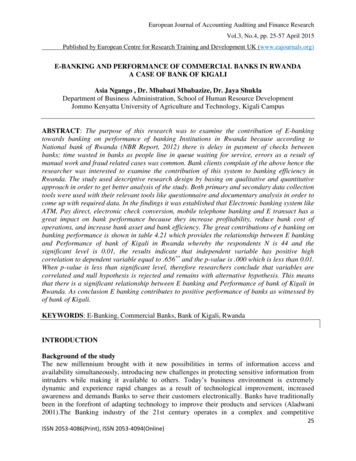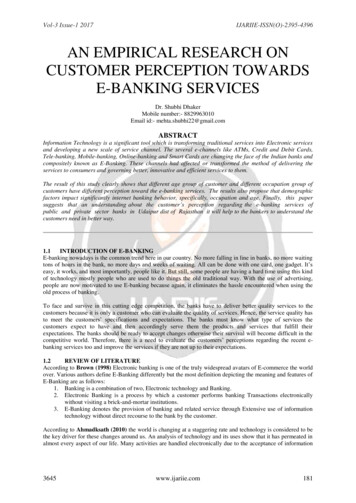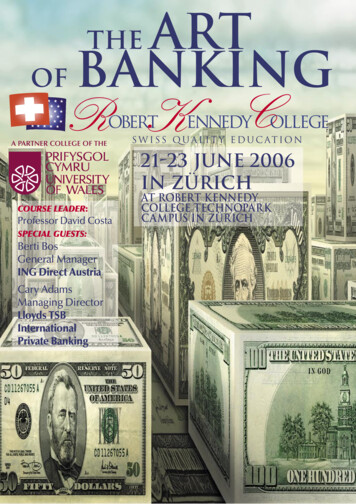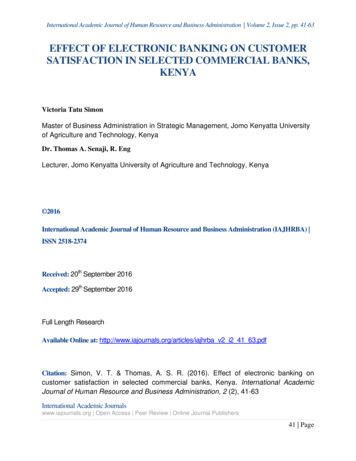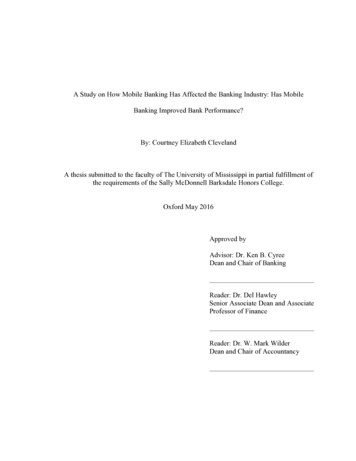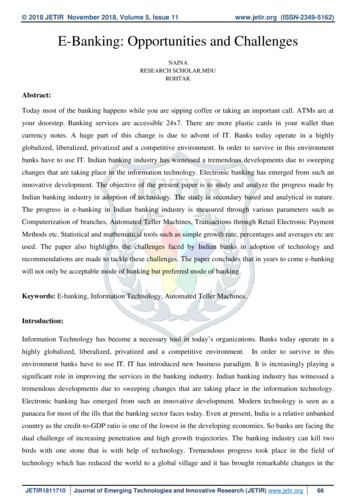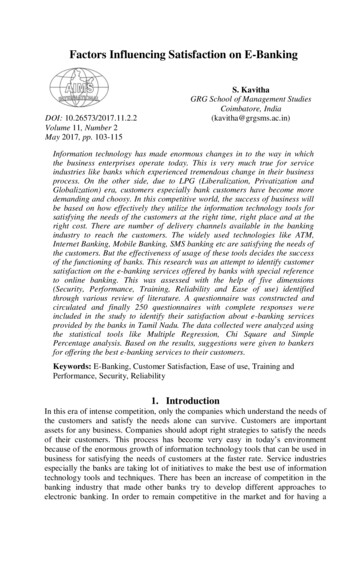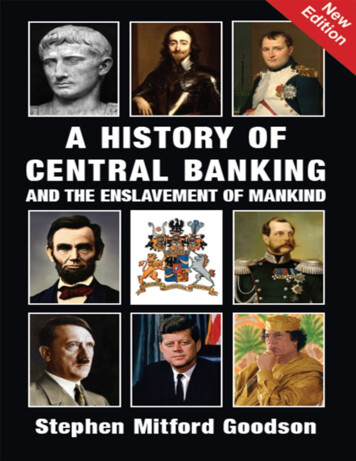
Transcription
A History of Central Banking andthe Enslavement of MankindbyStephen Mitford Goodson
And you will never understand American historyor the history of the Occident durin’ the past 2000 years unless you lookat one or two problems;namely, sheenies and usury.One or the other or BOTH. I should say, both.– Ezra Pound
By the Same AuthorGeneral Jan Christian SmutsThe Debunking of a MythInside the South African Reserve Bank:Its Origins and Secrets ExposedRhodesian Prime Minister Ian SmithThe Debunking of a MythHendrik Frensch VerwoerdSouth Africa’s Greatest Prime MinisterThe Genocide of the Boers
ContentsForewordIntroductionChapter IHow Usury Destroyed the Roman EmpireThe Copper Age (753 – 267BC)The Silver Age (267 – 27BC)The Jewish Role in the CollapseJulius CaesarThe Gold Age (27BC – 476AD)Role of the Church in the Decline and FallConsequencesChapter IIThe Hidden Origins of the Bank of EnglandAncient EnglandFirst Jewish Migration and ExpulsionThe Glorious Middle AgesEnd of a Golden EraCromwell and the English Civil WarThe Regicide of King Charles ISecond Jewish MigrationEstablishment of the Bank of EnglandWar and Debt Slavery in PerpetuityNationalisation
Chapter IIINapoléon and the Banque De FranceFrance under the BourbonsNapoléon the Monetary ReformerThe State Bank of the French EmpireAchievements of the French State Banking SystemChapter IVA Century of Struggle: Rothschild versus the PeopleCentral Banking in the United StatesEstablishment of the United States Federal Reserve BankThe State Bank of the Russian EmpireThe Creation and Control of the Soviet UnionRothschilds’ Responsibility for the Anglo-Boer WarThe Commonwealth Bank of AustraliaWorld War IChapter VThe Great DepressionThe Bank for International SettlementsUnited States Federal Reserve BankClifford Hugh DouglasIrving Norton FisherChapter VIThe Rise and Fall of State Banking (1932-1945)Reichsbank: The State Bank of National Socialist GermanyAchievements of the German State Banking System
Post World War II DevelopmentsFascist ItalyThe State Bank of ItalyThe State Bank of JapanHow Japan Was Forced into World War IIPost World War II DevelopmentsChapter VIIModern Forms of State BankingBank of North DakotaThe States of GuernseyCentral Bank of LibyaChapter VIIIThe Banking CrisisHistorical OverviewThe Banking Crisis 2007CausatumThe Great Depression of the 21st CenturyAppendix IAppendix IIAppendix IIIReview by Matthew JohnsonReview by Tom SunicBibliography
ForewordThis book is bound to be controversial and engender strong reactions,and I do not endorse all of the viewpoints expressed therein.Why would a seemingly arid subject matter such as the history of centralbanking and of the monetary system give rise to such strong reactions?One must wonder why some will attach to this book the stigma ofheresy, and argue that Stephen Goodson has gone beyond theparameters of acceptable historical debate.Goodson has the credentials and track-record to make a crediblepresentation of a subject matter which he has researched for decades andwhich he has lived personally as a non-executive Director of the SouthAfrican Reserve Bank.I do not have the expertise to say whether Goodson’s findings areaccurate, but I do know that the raw nerves he touches are on account ofcentral banking and the monetary system created thereunder being at thecore of the persistent profound and inhumane differences in wealthdistribution within any given country, and among countries.For this reason, for several years, my Party and I have argued that SouthAfrica should reform its central banking and monetary system, even ifthat means placing our country out of step with iniquitous worldstandards.Books on economics and banking are generally viewed as being abstruse,whose readers are confined mainly to academia and the business world.In this case we have a notable exception.This work provides not only a broad sweep of the history of economicsover almost three millennia, but insights into how the problems of usuryhave been confounding and enslaving mankind since its civilizedexistence first began.It may shock some to realise that central banks throughout the world,including our own South African Reserve Bank, do not serve our ownbest interests and are in fact in league with private banks. This not only
undermines our sovereignty, but deprives us of the means of havingpublicly-issued debt-free money which belongs to the people as itssovereign debt, and interest-free means of exchange. Instead, in ourcountry, as in other countries, we use private money produced out ofdebt by the private banking system. Shifting from bank-notes togovernment-notes would provide our people with a decent life, which isblessed, prosperous and sustainable. But such a simple reform would bea real revolution, more difficult to bring about than any other reform orsocial change imaginable.Although South Africa gained its freedom in 1994 in all its outwardmanifestations; inwardly, with the exception of a small minority of blackand white entrepreneurs, the general population has neither benefittednor thrived, and moreover has not realised its latent potential, mainlybecause of the defects in the monetary system. If we are to achieve realfreedom, it is imperative that monetary reform be pursued with the samevigour and intensity as was displayed towards political reform duringthe struggle years. But that requires understanding the complex issues ofhow money is created, whom it belongs to and whose interests it serves.In this book, Goodson has not only sketched numerous successes ofprevious states rather than private banking systems, but has alsoprovided us with a blueprint which may address many of ourentrenched social problems, such as low economic growth, highunemployment and declining services.Albeit decidedly controversial, this is a book which thinking SouthAfricans should read as an inspiration for political action.In his address before the American Newspaper Publishers Association on27 Apri, 1961, President John F. Kennedy famously stated: “Withoutdebate, without criticism, no administration and no country can succeed– and no republic can survive. That is why the Athenian lawmaker Solondecreed it a crime for any citizen to shrink from controversy.”Prince Mangosuthu Buthelezi MPPresident of the Inkatha Freedom PartyRepublic of South Africa
IntroductionHistory is the most crucial subject of any educational system supersedingscience and the humanities in importance. Within its fabric, it holds theculture, traditions, beliefs, ethos and raison d’etre necessary for thecontinued existence of any people. If history is compromised byfalsifications and omissions, which are frequently imposed by outsiders,then that civilisation will decay and finally collapse, as may be observedin the slow disintegration of Western civilisation since 1945. GeorgeOrwell expressed a similar sentiment in ‘1984’ when he wrote: “The mosteffective way to destroy people is to deny and obliterate their ownunderstanding of history.”Winston Churchill once made the observation that the further one goesback into history, the clearer the picture becomes. By employing thistechnique the author is hopeful that any doubts, which readers may haveconcerning his analysis and exegesis of modern historical events will beassuaged, if not entirely eliminated.For any nation/state/society/community to have full sovereignty andindependence in its affairs, absolute control over the means it employs toexchange goods and services must reside with the organs, whichrepresent the people, and must not be delegated to private individuals.Throughout recorded history periods of state control of the moneysupply have been synonymous with eras of prosperity, peace, culturalenrichment, full employment and zero inflation. However, when privatebankers usurp control of the money creation process, the inevitableresults are recurring cycles of prosperity and poverty, unemployment,embedded inflation and an enormous and ever increasing transfer ofwealth and political power to this tiny clique, who control thisexploitative monetary system. Whenever these private and centralbankers have been opposed in the past by nations seeking restoration ofan honest money system, these parasitic bankers have invariably invokeda “patriotic” war in order to defeat the much maligned “enemy”. Thishas been a feature of almost all wars during the past 300 plus years.
This book provides insights as to how private bankers since ancient timeshave abused monetary systems, whether they are based on coin, banknotes, cheque or electronic money, by creating money out of nothing asan interest bearing debt in order to arrogate supreme power tothemselves. It also provides a record, both ancient and modern, ofsocieties and civilisations which have flourished in an environment freefrom the burden of usury.The solution is simple and self-evident. If we wish to obtain ourliberation and sovereignty from the enslavement imposed by the privatebankers, we must dismantle their fractional reserve system of bankingand supporting central banks, or we ourselves shall be destroyed andconsigned to oblivion.Stephen Mitford Goodson
Chapter IHow Usury Destroyed the Roman EmpireMoney, being naturally barren, to make it breed money is preposterousand a perversion from the end of its institution, which was only to servethe purpose of exchange and not of increase. Men called bankers weshall hate, for they enrich themselves while doing nothing.– Aristotle, PoliticsThe monetary systems of the Roman era (753BC – 565AD) may bedivided into three distinct periods, where units of three different metalswere used as the means of exchanging goods and services.Althoughthere is evidence of modern human occupation (Homo sapiens sapiens) inthe Rome area going back 14,000 years (with Neanderthals having livedthere approximately 140,000 years ago), Rome, as a city, is traditionallysaid to have been founded by Romulus and Remus in 753BC in a regionsurrounding the Palatine Hills, also known as Latium. According to thelegend, Romulus (who killed his brother Remus) became its first king,but later shared the throne with Titus Tatius, the ruler of the Sabines.Around 600BC Latium came under the control of the Etruscans. Thislasted until the last king, Tarquin the Proud, was expelled in 509BC andthe Roman Republic was established. The Etruscans, a people of Aryanorigin, created one of the most advanced civilisations of that period andbuilt roads, temples and numerous public buildings in Rome.The first “money” used in Rome was the cow. This was not true money,but a barter system. Many early peoples used cattle as a medium ofexchange. According to the legend of Herakles and the Augean stables,the cattle kept there, over 3,000 in number, represented the treasury ofKing Augeas.The Copper Age (753 – 267BC)As time went on, the Romans took to using, instead of cattle, irregular
lumps of copper or bronze. These lumps were called aes rude (roughmetal) and had to be weighed for each transaction.There was an increase in trade and Rome became one of the mostprosperous cities in the ancient world. This prosperity was based onuncoined copper, later bronze, metal which was measured by weightaccording to a fixed system of units. It was issued by the RomanTreasury in the form of ingots weighing 3½ lbs (1.6kg) with the fullbacking of the state and was known as aes signatum (stamped metal),because it was stamped by the government with a cow, eagle or elephantor other image. Sometimes they were made to resemble a scallop shell. In289BC these ingots were replaced by discoidal, cast leaded bronze coinsaes grave (heavy metal). They represented national money and “werepaid into circulation by the state and [each was] only of value inasmuchas the symbols on which its numbers were recorded, were scarce orotherwise.” This money was thus based on law rather than the metalliccontent (although that content was standardised, and the coin did havesome intrinsic value, unlike most coins today). This can be considered asan early example of the successful use of fiat money.[1]While fiat money is much criticised in some quarters, for example by thefollowers of Austrian economist Ludwig von Mises, there is nothingwrong with it, as long as it is issued by government, not by privatebankers, and is carefully protected against counterfeiters. Non-fiatmoney, in contrast, has the serious drawback that whoever sets the pricesof gold and silver, i.e. private bankers, can control the nation’s economy.[2]
Roman Aes Grave, bronze coins 241-235 BC.Up to 300BC there was an unsurpassed increase in public and privatewealth of the Romans. This may be measured in the gain in land. Afterthe conclusion of the Second Latin War in 338BC and the defeat of theEtruscans, the Roman Republic increased in size from 2,135 square miles(5,525 sq km) to 10,350 square miles (26,805 sq km) or 20% of peninsularItaly. In tandem with the expansion of its land area the population rosefrom about 750,000 to one million with 150,000 persons living in Romeitself.A partnership was formed between the Senate and the people known asSenatus Populusque Romanus (SPQR, the Senate and People of Rome). Thepolitical leaders were renowned for their frugality and honest virtue. Themeans of exchange was strictly regulated in accordance with the increasein population and trade and there was zero inflation. Debt-bondagenexum, whereby a free man offered his services as security for a loan interest, and where in cases of non-payment the debt had to be workedoff, was abolished after Plebian agitation by the lex Poetelia in 326BC.[3]The Silver Age (267 – 27BC)The traditional money system was destroyed in 267BC when thepatrician elite obtained the privilege to mint silver coinage. This changewas typified by a patrician who went to the Temple of Juno Moneta(from whence the word money is derived), and converted a sack full ofsilver denarii to five times its original value by the simple expedient ofstamping a new value on the coins. He thus pocketed a very substantialdifference in seigniorage for his own private account.The early Roman silver coin was known as the drachma and wasmodelled on a coin used in the Greek south of the peninsula. It was laterreplaced with the smaller and lighter denarius. There was also a halfdenarius, called the quinarius and a quarter unit called the sestertius. Stilllater the system was supplemented with the victoriatus, somewhat lighterthan the denarius and probably intended to facilitate trade with Rome’sGreek neighbours.There were very few deposits of silver in the Italian peninsula and as a
consequence the Roman army had to be expanded, in order to conquerterritories to obtain supplies. The Roman peasants, who had providedthe Republic with food independence, were drafted in increasingnumbers into the army. Agricultural production, especially corn,declined and the peasant farms were replaced by latifundia, which werelarge estates worked by slaves. Wheat also had to be imported fromNorth Africa.Tensions about granting citizenship and enfranchisement between Romeand her Italic allies resulted in the Social War (90-89BC). This lack ofenfranchisement had led to the fragmentation of Roman society and thealienation of the working class citizens, who were treated as chattel andwho had no responsibilities and therefore no commitment towards thestate. Until as late as the Second Punic War (218-201BC), they were notallowed to serve in the army. This is a classic example of a society whichhad been monetarised. The Republic was weakened and there wasincreasing despotism. Piracy became a major problem, with raids takingplace on the coast, villas being sacked and travellers kidnapped. Violencebecame endemic and gangsters and terrorists were active in Rome, asthere was no police force to maintain law and order. These are inevitableconsequences of a society in which money has become the highest ethos.Roman Republican silver Denariuswith (left) goddess Juno Moneta and (right) a victorious boxer.There was also political intrigue amongst the elite. Economic deprivation
caused discontent amongst the poor, who were increasingly slaves fromNorth Africa, and social unrest. This turmoil culminated in the revolt ledby Spartacus in 73-71BC. (The first and second revolts were in 135-132BCand in 104-100BC).The Jewish Role in the CollapseThefirstknown Jewswhoarrivedin Romein 161BC,were Yehuda andMaccabee. These early Roman Jews employed themselves as craftsmen,peddlers and shopkeepers. In the last occupation they also indulged inmoney lending. As a community they lived separately in apartments.They governed themselves according to their own laws and were exemptfrom military service.
Expulsion of the Jews from Rome by Emperor Hadrian 135AD. From a 15th Century manuscriptin the Bibliothèque de l’Arsenal in Paris.In 139BC the Jews, who were not Roman citizens, were expelled byPraetor Hispanus for proselytising, but they soon returned. In 19AD bymeans of a senatus consultum Emperor Tiberius expelled 4,000 Jews, whohad been involved in various scandals, but none of these expulsions wasproperly enforced and their continued presence, in particular as usurers,would play a significant role in the decline and collapse of the RomanEmpire.Julius Caesar. Commissioned in 1696 for the Gardens of Versailles.Julius CaesarJulius Caesar (100-44BC) was born into an aristocratic family on July 12,100BC. He was tall and fair-headed and practised briefly as a lawyer
before becoming a brilliant military commander who conquered Gaul(France) in 59-52BC. After his defeat of Pompey the Great in 48BC atPharsalus, Caesar became the undisputed leader of the Roman Republic.On his return to Italy in September 45BC, Caesar found the streets andcities crowded with homeless people, who had been forced off the landby usurers and land monopolists. 300,000 people had to be fed daily atthe public granary. Usury was flourishing with disastrous consequences.[4]The Forum Romanum was commissioned by Julius Caesar in 54BC and dedicated by him in46BC. It was the very centre of ancient Rome where Caesar would meet his untimely end onMarch 15, 44BC.The principal usurers,many of whom were Jewish, were charginginterest rates as high as 48% per annum. As Lucius Annaeus Seneca(4BC-65AD), the philosopher, would later remark in de Superstitione “Thecustoms of that most criminal nation have gained such strength that theyhave now been received in all lands. The conquered have given laws tothe conqueror.”[5]At that time there were two main political parties: the Optimates centeredaround the nobility, the Senate and the privileged few; and the Populares,who represented the citizens. Caesar immediately assumed leadership of
the latter.Caesar fully understood the evils of usury and how to counter them. “Herecognized the profound truth that money is a national agent, created bylaw for a national purpose, and that no classes of men should withhold itfrom circulation so as to cause panics, in order that speculators couldadvance the rates of interest, or could buy up property at ruinous pricesafter such panic.”[6]Caesar introduced the following social reforms:1. Restoration of property was done at the much lower valuationswhich held prior to the civil war. (49-45BC).2. Several remissions of rents were granted.3. Large numbers of poor citizens and discharged veterans were settledon allotments.4. Free housing was provided to 80,000 impoverished families.5. Soldiers’ pay was increased from 123 to 225 denarii.6. The corn dole was regulated.7. Provincial communities were enfranchised.8. Confusion in the calendar was removed by fixing it at 365¼ daysfrom 1 January 44BC.His monetary reforms were as follows:1. State debt levels were immediately reduced by 25%.2. Control of the mint was transferred from the patricians (usurers) togovernment.3. Cheap metal coins were issued as the means of exchange.4. It was ruled that interest could not be levied at more than 1% permonth.5. It was decreed that interest could not be charged on interest and thatthe total interest charged could never exceed the capital loaned (induplum rule).6. Slavery was abolished as a means of settling debt.7. Aristocrats were forced to employ their capital and not hoard it.
Gold coin minted by Emperor Alexander Severus 222-235AD.These measures enraged the aristocrats and plutocrats whose“livelihood” was now severely restricted. They therefore conspired tomurder Caesar, the hero of the people. On that fateful morning of 15March 44BC, only four years after assuming power he arrived at theSenate building unarmed, having dismissed his military guard, who hadpreviously been in constant attendance. Surrounded by 60 conspiratorshe was stabbed to death and received 23 wounds.The Gold Age (27BC – 476AD)In 27BC shortly after Caesar’s death (and his deification) the Romansadopted the gold standard, which would have far reaching implicationsfor the financial stability of the empire and lead directly to its demise.Previously, during the days of the Roman Republic, gold coins wereissued only in times of great need, such as during the Second Punic Waror the campaign of Lucius Cornelius Sulla. There were few gold mines inEurope, except in remote places like Wales, Transylvania and Spain andtherefore most of the supplies could only be secured from the east. Thisin turn required a large and expensive army, which became engaged inconstant conflict at the empire’s fringes.The gold coin was known as an aureus.Also in circulation were the silverdenarius and various copper coins: the sestertius, dupondius and the as.The scarcity of gold or commodity money frequently induced periods ofdeflation as a result of the lack of a circulating means of exchange. In
13BC a measure of relief was provided when the weight of the goldaureus was reduced from 122 to 72 grains and this remained the standardweight until 310AD. However, metals continued to flow eastwards inorder to pay for luxury items, religious dues and usury payments.Furthermore wear and tear resulted in the loss of one third of totalcoinage in circulation over a 100 year period.As gold was treated as a commodity, its debasement was not tolerated.Emperor Constantine (275-337AD) personally ordered death forcounterfeiting, and the burning of public minters who committedfalsification. Money changers, who did not report a counterfeit goldbezant (solidus), were immediately flogged, enslaved and exiled. Theseregulations were effective for the bezant, which weighed 70 grains andwas slightly more than the bezant that was still circulating in 1025ADand weighed 68 grains.In 313AD Christianity was tolerated by the Edict of Milan and from380AD was established as the official religion by Emperor Theodosius religiousauthorityofthe pontifexmaximus.Afeature of theimperial era was social injustice and the undermining of the middleclasses through excessive taxation. The Roman businessman was not atrader, but a looter of the provinces, as the homeland had a weakindustrial production base, which was incapable of providing therequired manufactured goods. As the monetarisation of societycontinued, with the rich parasitising of the common man, the plebiansbecame more like slaves. The abolition of the jury system wassymptomatic of the declining respect and importance for the commonman in Roman society.Role of the Church in the Decline and FallThe tax that Emperor Constantine decreed, viz. that 1/10 of all incomehad to be tithed to the Christian church, hastened the destruction of theempire. Eventually the Church held one third to one half of all lands andaccumulated wealth. This concentration of wealth produced a greatscarcity of coinage. Money existed, but there was no circulation ordistribution of goods and services. Instead of recycling the tithed money
by means of investment in the community or charitable works such asconstruction of hospitals, schools and libraries, vast hoards of gold wereconcentrated behind the 20 foot (6.1m) thick walls of the fortress city ofConstantinople and the Vatican fortress in Rome.In its last years in the fifth and sixth centuries the Roman Empire hadbecome a parasitic organism, subject to alternating phases of inflationand deflation. Its economic ruination preceded its political ruination.There was no industrial production, almost all food had to be importedand usury was practised on an unprecedented scale. The wealth of theempire that was not held by the Church, was controlled by 2,000 Romanfamilies. The rest of the population lived in poverty.ConsequencesThe implosion of the western half of the empire in 476AD, after repeatedmilitary incursions by the Goths and Vandals, resulted in the Dark Ages.A punishing multi-century deflationary depression followed. Accordingto the United States Silver Commission of 1876 the metallic money of theRoman Empire at its height amounted to 1.8 billion, but by the end ofthe Dark Ages it had shrunk to 200 million. Agriculture was reduced tosubsistence level. Large sailing vessels vanished as there was no trade.Commerce stagnated. Arts and science were lost and the knowledge ofcement-making disappeared.Major factors in the decline of the Roman Empire were the concentrationof wealth, the absence of mining deposits for industrial production, andthe vast importation of non-White slaves with the resultant degradationof the genetic value of the nation. By the 4th century AD, as a result ofthe continuing decline in Roman female fertility, slaves outnumberedcitizens by five to one. The most important economic reason was aninadequate supply of an inexpensive circulating medium of money andthe false notion that money should be a commodity. Thus from aneconomic perspective, the lessons from the fall of Rome are that adishonest economic system will inevitably contribute to the forces ofdissolution. No society can survive a false economic system. For anysociety to function and prosper it is absolutely fundamental that themeans of exchange be issued free of debt and interest by the legal[7]
authority of the state as representatives of the people in perpetuity.
Chapter IIThe Hidden Origins of the Bank of England all great events have been distorted, most of the important causesconcealed If the history of England is ever written by one who has theknowledge and the courage, the world would be astonished.- Benjamin Disraeli, Prime Minister of Great BritainAncient EnglandKing Offa ruled the Kingdom of Mercia, which was bounded by therivers Trent and Mersey in the north, the Thames Valley in the south,Wales in the west and East Anglia and Essex in the east from 757 to 791AD. It was one of the seven autonomous kingdoms of the Anglo-SaxonHeptarchy.[8]Offa was a wise and able administrator and a kind-hearted leader. Heestablished the first monetary system in England. On account of thescarcity of gold he used silver for coinage and as a store of wealth. Thestandard unit of exchange was a pound of silver divided into 240pennies. The pennies were stamped with a star (Old English stearra),from which the word sterling is derived. In 787 King Offa introduced astatute prohibiting usury, viz. the charging of interest on money lent, aconcept which dates back to the pagan era. The laws against usury werefurther entrenched by King Alfred (865-99), who directed that theproperty of usurers be forfeited, while in 1050 Edward the Confessor(1042-66) decreed not only forfeiture, but that a usurer be declared anoutlaw and be banished for life.First Jewish Migration and ExpulsionThe Jews first arrived in England in 1066 in the wake of William I’sdefeat of King Harold II at Hastings on 14 October. These Jews camefrom Rouen, 75 miles (121 km) from Falaise in Normandy,where William
the Conqueror was born illegitimately as William the Bastard. Althoughthe historical record does not indicate whether they promoted the idea ofa military invasion of England, these Jews had at the very least financedit. For this support they were richly rewarded by being allowed topractise usury under royal protection.[9]The consequences for the English people were disastrous. By chargingrates of interest of 33% per annum on lands mortgaged by nobles and300% per annum on tools of trade or chattels pledged by workmen,within two generations one quarter of all English lands were in the handsof Jewish usurers. At his death in 1186, Aaron of Lincoln was declared tobe the richest man in England and it was estimated that his wealthexceeded that of King Henry II. Furthermore the Jewish immigrantsundermined the ethos of the guilds and exasperated the Englishmerchants by selling a large variety of goods under one roof. They alsoplayed a prominent role in the clipping of silver coins and the melting ofthem into bullion and the plating of tin with silver.[10]The famous economist, Dr. William Cunningham, compares “the activityof the Jews in England from the eleventh century onward to a sponge,which sucks up all the wealth of the land and thereby hinders alleconomic development. Interesting too, is the proof that even at thisearly period the government did everything in its power to make theJews take up decent trades and honest work and thereby at the sametime amalgamate with the rest of the population, but all to nopurpose.”[11]By the beginning of the 13th century many nobles were in danger oflosing their lands through usury and taxation. In 1207 an enormous sumof 60,000 was levied in taxes on the Christian population. The Jews alsopaid tax, but at a lower rate and on grossly understated income andwealth. Nobles who borrowed from Jewish moneylenders and from theKing and his agents had to have their mortgages registered on theTreasury Rolls. As soon as a noble got into financial difficulty, the Kingwould buy the debt from the moneyl
This book provides insights as to how private bankers since ancient times have abused monetary systems, whether they are based on coin, bank notes, cheque or electronic money, by creating money out of nothing as an interest bearing debt in order to arrogate supreme power to themselves. It also provides a record, both ancient and modern, of
